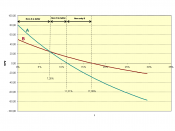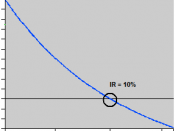The internal rate of return (IRR) and the net present value (NPV) techniques are 2 investment decision tools that satisfy the 2 major criteria for the correct evaluation of capital projects. This criterion is that the techniques should incorporate the use of cash flows and the use of the time value of money. This makes them viable techniques for evaluating investment proposals.
The Net Present Value is one of the techniques that are used by firms when evaluating which investment proposals to take on board and which ones to reject. The net present value is calculated by discounting all flows to the present and subtracting the present value of all inflows.
As cited by Petrochilos G 2004, the Net Present Value principle advises us to invest in the project as long as its Net Present Value is positive, and reject the investment suggestion if its Net Present Value is negative.
The reason given by Petrochilos G, 2004, is that when the flow of future returns is discounted at the cost of capital, and gives a positive NPV, the project can cover both interest and depreciation charges, and thus, the positive NPV represents a clear profit, which increases the wealth of the firm.
In the case of a negative NPV, the condition as referred to by Petrochilos, tells us that we shall lay yourself open to a loss in our internal venture opportunity, thus, should not invest, but consider, instead, using the outer opportunities by lending any money in the capital market.
Formula:Wheret - The time of the cash flowN - The total time of the projectr - The discount rate (the rate of return that could be earned on an investment in the financial markets with similar risk.)Ct - the net cash flow (the amount of cash) at time t...


